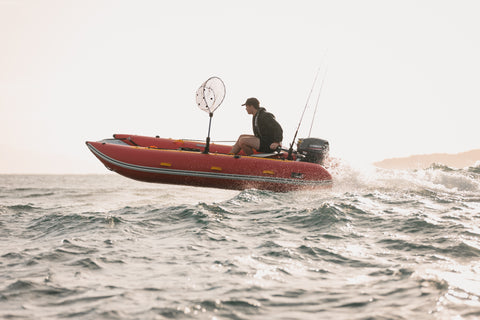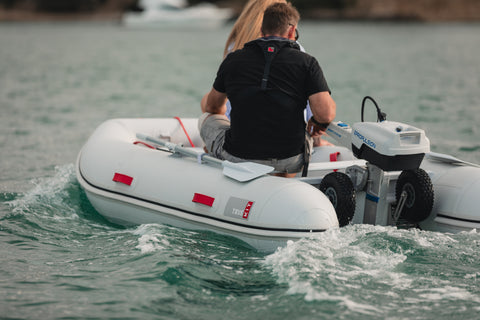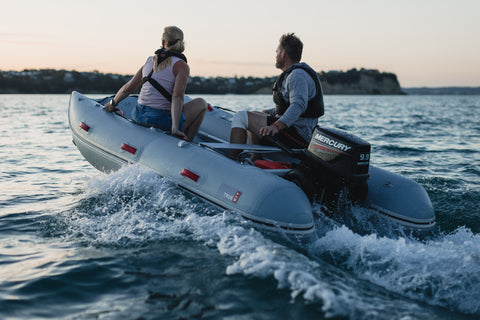Navigating the Waters: Picking the Perfect Outboard Motor for Your True Kit Inflatable
Imagine cruising into hidden coves and serene beaches with ease. The secret? Choosing the right outboard for your True Kit inflatable. The outboard motor, your trusty steed that promises speed, power, and reliability. Yet, with such a choice of outboards between different brands, difference sizes, different fuel options, petrol vs electric… choosing the right motor can be a complex issue. Here we embark on a journey to demystify the art of selecting the ideal outboard motor for your True Kit inflatable, blending expert insights with a dash of playful curiosity.
Brandishing the Brand: A Signature of Reliability
Yamaha, Mercury, Tohatsu, Honda, Suzuki, ePropulsion, Torqeedo… the options go on and on.
The brand of your engine is is often about peace of mind through reliability and your service options available. All of the main brands mentioned above should offer you the reliability you expect. Getting your outboard serviced annually is important so choosing a nearby retailer who also does the servicing could well be the right call. Yamaha is a brand that stands tall when it comes to reliability.
Power Play: Engine Strength and Boat Bliss
The power of your engine is a pivotal factor in determining the zest of your voyage. It's about finding the sweet spot between power and weight, speed and practicality. Consider how fast you want to go and the load you aim to carry. What are your needs? How many people do you intend to carry aboard regularly? How much weight can you personally lift on and off the boat?
Personally I find up to around 36kg (80lbs) comfortable enough to lift and move around, but once you get over that it becomes hard work. Luckily there are some clever solutions to move heavier outboards around so they are worth looking into if you are considering a 20hp motor.

Featherweight Champions: The Weight of the Matter
The weight of your engine plays a starring role in the performance of your True Kit inflatable. A lighter engine ensures easy handling and better fuel efficiency. Yet, it must still possess the muscle to propel you forward with gusto. Look carefully into the specifications of the comparative outboards across different brands. You will find that at one power point one brand will be the lightest, and then at another power point another brand will be the lightest. Tohatsu is a brand that often stands out when it comes to building lighter outboards in the 5-20hp range.
The Heartbeat of Adventure: Choosing Between 2-Stroke and 4-Stroke
The choice between a 2-stroke and a 4-stroke engine is often made for you depending on where in the world you are located. In many countries now, only 4-stroke engines can be purchased new. This is rightfully to do with emissions and keeping our beautiful waterways pristine. 4-stroke engines are also significantly more fuel efficient. However if 2-strokes are available in your region, and weight is an absolutely critical factor, consider a trusted, classic 2-stroke engine.
The Green Tide: Petrol vs. Electric
Electric motors whisper promises of quiet operation, minimal maintenance, and a green footprint, perfect for serene lake explorations. Petrol engines, on the other hand, offer longer range and robust power, suited for those who like to chart distant horizons. Your choice should reflect your intended use case.. The smaller electric motors like the ePropulsion Spirit and the Torqeedo Travel can be ideal for those who want a clean, quiet motor for a tender. They are great for ship to shore purposes. However, don’t expect great speed from these little gems - they are for slow cruising only.
Currently the larger electric motors require extremely heavy batteries to get any reasonable range out of them so aren’t really suited to True Kit inflatables… but stand by as the battery technology is changing fast. For those who like to go long distances and at speed, a traditional petrol outboard is the way to go.

A Safe Harbour: Storing Your Engine
The way you store your engine when not slicing through waves is crucial. A small electric motor with the battery removed can be stored any way you like. A 2-stroke motor can be stored on any side also. However, with a 4-stroke engine you need to store it according to the manufacturers instructions. If you don’t you risk oil pouring out of it. When transporting a 4-stroke engine, we recommend keeping the power head elevated above the shaft end.
The First Spark: Starting Your Engine
The ritual of starting your engine is the first step in your aquatic journey. 20hp modern engines offer electric starts, a simple turn of a key is all that is needed. Traditional pull-starts can be quite a hard manual task. If your shoulders aren’t the best, consider getting an electric start option. One of the real benefits of the electric motors like an ePropulsion is that there is no pull start required, simply turn the throttle and off you go.
Matching your Outboard to your True Kit
Each boat in our range has a maximum horsepower rating. This rating is determined by a combination of factors, including size of the boat, construction, buoyancy, weight. It is important to not exceed the maximum recommended power rating for your boat. One important and often overlooked factor is that the longer the boat, typically the better it will go with the same outboard motor on it. While this isn’t a 100% perfect rule, it gives a good indication of performance. Sometimes going for a longer boat is as good as going up in outboard size.

Optimising your Outboard
Check out our previous article here about how to squeeze the very best performance from your True Kit inflatable. We go into details like weigh distribution, Permatrims, propellers and more.
Embarking on Your Quest
Choosing the right outboard motor for your True Kit inflatable is a journey of matching your aquatic dreams with the perfect blend of power, efficiency, and spirit. As you navigate through these considerations, remember that the ideal engine is one that complements what you are trying to achieve.

































